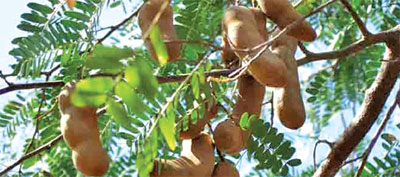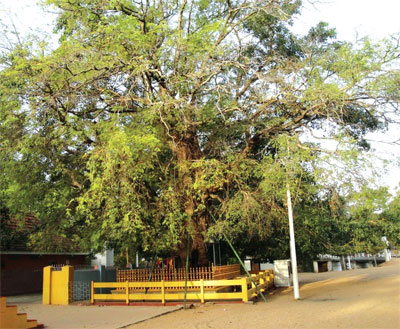Orubendi Siyambala gaha

by Sumana Saparamadu
There are a few trees with a history. I wrote about one - Knox's
tree. This is another tree with a history.
Orubendi Siyambala gaha, "tamarind tree to which boats were tied." A
strange name for a tree, isn't it? It is one of the three trees
protected under the Fauna and Flora Protection Ordinance of 1937. The
other two are Knox's tree about which I wrote and a Mal Madara tree
which is no more.
This is a giant tamarind tree growing by the side of the Elahera Yoda
Ela about 5 1/4 miles from the Elahera anicut. It is in the Matale
district.
How did this tree get this name?
In ancient times when roads were few, people went by boat on canals.
Tradition says King Mahasena (334 AD) used to travel from Polonnaruwa to
Elahera on the Yoda Ela and the royal barge was tied to this particular
tree.
 The tree was discovered by accident in 1850 by three engineers who
were directed by Governor Henry Ward to report on the ancient irrigation
tanks and canals in the North Central Province. The tree was discovered by accident in 1850 by three engineers who
were directed by Governor Henry Ward to report on the ancient irrigation
tanks and canals in the North Central Province.
They reported, "about a mile and a half from the last breach stands a
gigantic tamarind tree, on the top of the embankment. This tree is
called Orubendi Siyambala gaha. Tradition says that boats stopping there
on their transit up and down the canal were fastened to it and the
natives point out some scars near its root which they say are the marks
of chains and ropes.
There is no other tree approaching it in size and it is evidently a
tree of very great age."
At that time the tree was 26 feet and two inches in girth. In the
1960s it was about 29 feet in girth and 65 feet tall. The trunk growing
straight up for about 24 feet, spreads into three main branches. The
trunk of the main tree developed a hollow in the centre, as it
frequently happens in tamarind trees.
Knox's tree developed a hollow and was knocked down in the cyclone of
1958. The same could happen to this tree. About seven feet from this
tree there is a sapling about 3 1/2 feet in girth. |

